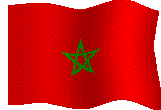Moroccan cities
The Kingdom of Morocco is located at the western end of North Africa. Known to the Arabs as al-Maghreb al-Aqsa, or "the farthest west," it was the center of Berber Islamic kingdoms that once included much of Spain and North Africa. France established a protectorate over Morocco in 1912 and granted independence in 1956. Morocco has a 1,140-mile (1,835- kilometer) coastline on the Atlantic Ocean and the Mediterranean Sea. The Strait of Gibraltar separates Morocco from Spain. Algeria borders Morocco on the east, and to the south Western Sahara is a disputed territory under Moroccan occupation
Northen of morocco
Northern Morocco has a Mediterranean climate. Rainfall in the Rif and Middle Atlas averages 30 inches (75 centimeters) annually and falls in the warm winter months. Summers are hot and dry. The mean annual rainfall at Fes is 21 inches (54 centimeters) and the temperature 63 F (17 C). Rainfall decreases and temperatures increase southward in the lowlands. The mean annual rainfall at Casablanca is 18 inches (47 centimeters) and at Marrakech 9 inches (23 centimeters) with a temperature of 67 F (19 C). During the summer hot dry winds from the Sahara reach the southern plains. The cool, offshore Canary Current moderates coastal temperatures and rainfall.
The Atlas Mountains are covered by forests of evergreen, oak, and cedar. Because of widespread deforestation from overgrazing, burning, and fuelwood gathering, as well as sparse rainfall, scrub bushes and grasses cover the lower slopes and lowlands. The cork oaks at Mamora near Rabat are the only remnants of the vast forests that once covered the plain. On the southeastern slopes of the High Atlas and the lowlands that extend into the Sahara, steppe grasslands, and drought-resistant scrub vegetation cover much of the area. Intermittent streams drain from the Atlas into the Sahara. Where gorges cut through the Anti-Atlas, date-palm oases extend into the desert. Elsewhere large areas have no vegetation.
The majority of the more than 20 million Moroccan people live in rural areas. They are concentrated in the valley of the Oued Sebou and the Atlantic lowland plains. The average annual rate of population growth is 3.3 percent. Arabic is the official language. French is taught as a second language and is widely used in commerce and government. One third of the people speak Berber languages. They live in towns and villages in the Atlas Mountains and in the Saharan lands. Arabic-speaking people live primarily in cities and towns in the lowlands and agricultural lands. Islam is the state religion. An estimated 28 percent of the adult population are literate. Primary and secondary education are compulsory. The University of al-Quarawiyn, founded in 859, is in Fes. The Muhammad V University, founded in 1957, is in Rabat.
Morocco economie
Half of Morocco's labor force is employed in agriculture. Wheat, barley, and corn (maize) are the main cereal crops. Citrus fruits, vegetables, and olives are also abundant. Sugarcane and sugar beets are grown on a large scale to reduce sugar imports. The herds of cattle, sheep, and goats are generally of poor quality. Rich fishing grounds are offshore in the Atlantic.
About one third of Morocco is arable. The richest agricultural lands are in the Oued Sebou Valley and the Atlantic lowland plains. Most crops are grown by dry-farming methods with irrigation necessary in the southern lowlands. Crop production varies widely because of drought and erratic rainfall. In the 1980s Morocco imported cereals, sugar, and dairy products as demand exceeded domestic production. A large-scale water development program is underway to increase irrigated agriculture.
Morocco is rich in calcium phosphates. It is the world's third largest producer and the leading exporter. Phosphate rock, phosphoric acid, and fertilizer are Morocco's principal sources of export earnings. Calcium phosphate is mined at Khouribga, Youssoufia, and Benguerir, and Bu Craa in Western Sahara. Rock is processed at Safi for export through the ports of Casablanca, El Jorf-Lasfar, and Layoun. Some coal, iron ore, lead, zinc, and manganese are mined.
The production of phosphates is Morocco's main industry. Petroleum refining, food processing, and the production of cement, textiles, and chemicals are also significant. Morocco is almost entirely dependent on imported crude petroleum. Production from the Sidi Ghalem field is small, and plans to develop oil-shale deposits in the Atlas Mountains were abandoned. Petroleum refineries are located at Mohummedia and Sidi Kacem, and one is planned for El Jorf-Lasfar. The textile industry has expanded, and metal industries are planned to use Morocco's extensive mineral resources.
Morocco has the capacity to generate 3,838 megawatts of electricity two thirds by oil and the rest by waterpower. Increased coal imports are planned to replace oil. Morocco has vast hydroelectric potential in the Atlas Mountains.
Casablanca is the largest city with a population of about 2.6 million; Rabat is the capital city and, together with the adjoining city of Sale, has a population of nearly 810,000 (see Casablanca; Rabat). Fes, Marrakech, Meknes, and Tetouan are other population centers. Morocco has ten major ports. Phosphate exports and petroleum imports are the principal commodities handled. Tangier is the main passenger port and an international free-trade zone (see Tangier). The transportation system is well-developed in the north and west with 35,787 miles (57,594 kilometers) of road, about half paved, and 1,105 miles (1,778 kilometers) of railway connecting the principal cities and ports. Transportation through the Atlas Mountains is limited. Morocco has eight international airports, the major ones serving Tangier and Rabat-Sale
Email me

Want to send us a brief note? Email us at
plaxiadoll@mailcity.com
